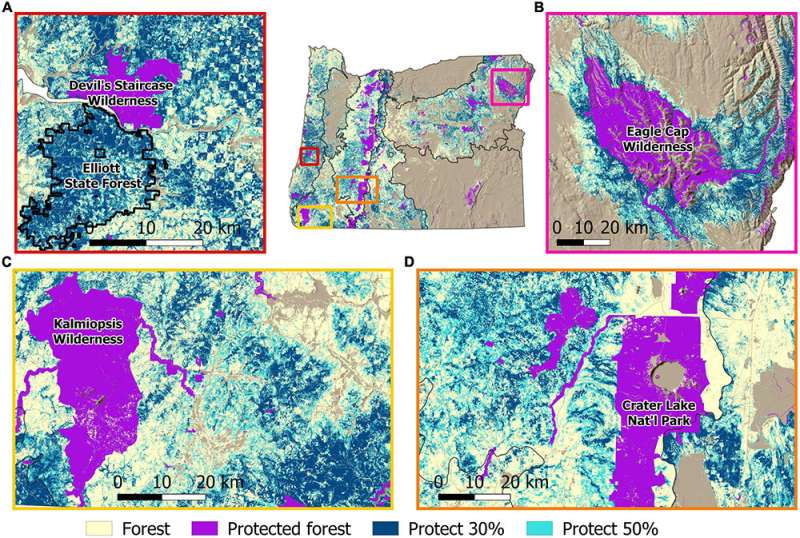Strategic reserves in Oregon's forests to prevent biodiversity losses, protect water, and mitigate climate change

Without substantial and sustained reductions in global greenhouse gas emissions and removal of carbon dioxide from the atmosphere by forests and oceans (natural climate solutions), the nation is put at significant risk of abrupt and severe biodiversity losses and transformative impacts to natural systems. According to the Intergovernmental Panel on Climate Change (IPCC), the next 10 to 30 years are a critical window for climate action, when severe ecological disruption is expected to accelerate.
A new paper in the journal Frontiers in Forests and Global Change identifies which forests in Oregon are poised to provide significant benefits to the nation as strategic forest reserves that help prevent biodiversity loss, mitigate climate change, and protect drinking water. Oregon has forests that are among the highest carbon density forests in the world and protecting mature and older forests found here can increase carbon storage and accumulation while protecting wildlife and clean water.
Of the eleven western United States, Oregon has the most total forest area and carbon in live tree biomass but the lowest proportion (10%) that is protected at the highest levels, as wilderness areas or strict nature reserves. The study shows that the Coast Range ecoregion has the lowest percentage of its forest lands protected compared to other ecoregions.
The team of experts led by Dr. Beverly Law at Oregon State University developed a framework for identifying the highest priority areas for protection in Oregon and produced detailed maps that can guide immediate action on biodiversity conservation and climate change mitigation. The framework uses fine resolution spatial data to map high priority forestlands, including a new forest carbon map (30 m resolution).
Compared with prior work, this new scientific research provides a finer scale analysis and includes a resilience metric that represents landscape connectivity and topography for wildlife movement and habitat suitability, and identifies areas within each ecoregion that are ranked high priority for carbon density, biodiversity and surface drinking water. Using an ecoregion-based conservation approach ensures there is enough un-fragmented habitat to maintain viable populations of native wildlife.
National and international targets identify how much needs to be protected. Many countries have already pledged to protect 30% of their land and water areas by 2030 for biodiversity conservation, carbon and water. Protecting 50% of land and water by 2050 is widely viewed as critical to protecting global biodiversity.
The authors found that Oregon's surface drinking water sources and forest habitat for birds, mammals, amphibians and reptiles could increase to 50 to 70% protection at the highest levels by 2050. Protected aboveground biomass carbon could triple by 2050. Most of high preservation priority areas are on federal lands (67%) followed by private lands (28%). Public lands can more readily ensure permanence of protection through time. Doing so would provide clean drinking water and habitat for wildlife.
More information: Beverly E. Law et al, Strategic reserves in Oregon's forests for biodiversity, water, and carbon to mitigate and adapt to climate change, Frontiers in Forests and Global Change (2022). DOI: 10.3389/ffgc.2022.1028401
Provided by Conservation Biology Institute




















